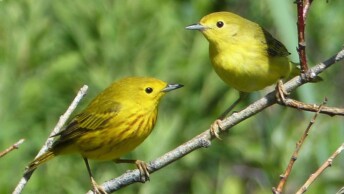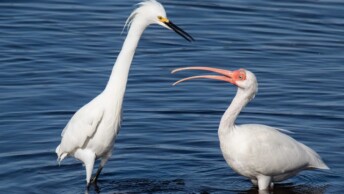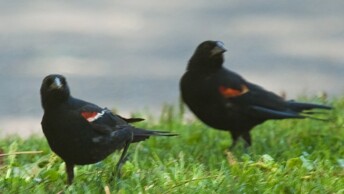California’s wetlands come alive with the sights and sounds of ducks throughout the year. From the vibrant Cinnamon Teal to the familiar Mallard, these waterfowl paint a dynamic picture of the state’s rich biodiversity. The seasonal ebb and flow of duck populations highlight the intricate dance between breeding and migration.
In the spring and summer, California’s lakes and marshes host numerous breeding species, while the fall and winter months bring an influx of migratory ducks seeking refuge from colder climates. As climate patterns shift and habitat conservation becomes increasingly vital, understanding these patterns is crucial for the preservation of these iconic birds.
Ducks not only contribute to California’s natural beauty but also play a significant role in the ecosystem, making their conservation a priority for wildlife enthusiasts and researchers alike.
1. Mallard
- Scientific name: Anas platyrhynchos
- Life span: 5-10 years
- Size: 50-65 cm (20-26 in)
- Weight: 700-1600 g (1.5-3.5 lb)
- Wingspan: 81-98 cm (32-39 in)
- Status: Least Concern
- State status: Breeding and common
The Mallard is one of the most recognizable ducks, with its vibrant green head, white neck ring, and chestnut-brown chest. Found throughout North America, Europe, and Asia, Mallards are common in ponds, lakes, and wetlands.
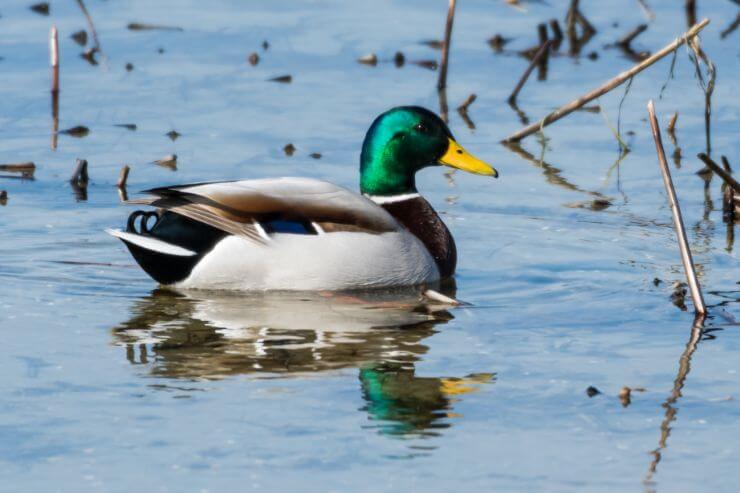
Mallards are adaptable nesters, often choosing secluded spots near water but not shying away from urban environments. They typically create a nest lined with down feathers in dense vegetation, tall grass, or even human-made structures like gardens and rooftops. Female Mallards lay a clutch of around 10-12 eggs and incubate them for about 28 days.
Mallards are opportunistic feeders, dabbling on the surface of the water to eat a variety of plant material, insects, and small aquatic animals. They have a diverse diet that includes seeds, aquatic vegetation, and invertebrates. This varied diet allows them to thrive in many different habitats, from freshwater lakes and rivers to urban parks.
Mallards are abundant and widespread, but conservation efforts have focused on habitat preservation and wetland management to ensure their populations remain stable. Historically, Mallards have benefited from conservation programs that protect and restore wetlands, crucial for their breeding and feeding. Organizations like Ducks Unlimited have played significant roles in these efforts, ensuring that these adaptable ducks continue to thrive across their vast range.
2. Gadwall
- Scientific name: Mareca strepera
- Life span: 5-10 years
- Size: 46-56 cm (18-22 in)
- Weight: 800-1,350 g (1.8-3 lb)
- Wingspan: 81-95 cm (32-37 in)
- Status: Least Concern
- State status: Breeding and common
The Gadwall is a subtly beautiful duck with intricate gray and brown feather patterns. Often overlooked, these ducks are found across North America, Europe, and parts of Asia, typically inhabiting freshwater lakes and marshes.
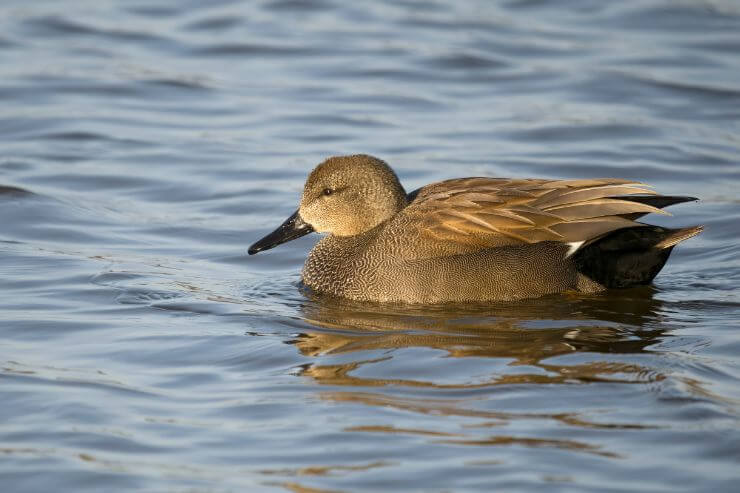
Gadwalls prefer to nest in dense, grassy areas close to water. The female builds a well-concealed nest on the ground, lining it with down feathers. She lays about 7-12 eggs, and incubation lasts approximately 24-27 days. Gadwalls are known for their secretive nesting habits, often making their nests difficult to find.
Gadwalls primarily feed on aquatic vegetation, seeds, and small invertebrates. They dabble and graze on the water’s surface, often foraging in shallow wetlands and ponds. Their diet shifts with the seasons, incorporating more invertebrates during the breeding season for extra protein.
Gadwalls have benefited from wetland conservation efforts aimed at protecting their habitats. Historically, their populations have been stable, but they are susceptible to habitat loss and changes in water quality. Conservation programs that focus on wetland preservation and management are crucial to maintaining healthy Gadwall populations.
3. Bufflehead
- Scientific name: Bucephala albeola
- Life span: 12-15 years
- Size: 32-40 cm (13-16 in)
- Weight: 270-550 g (9.5-19.4 oz)
- Wingspan: 46-54 cm (18-21 in)
- Status: Least Concern
- State status: Migratory and common
Buffleheads are small, diving ducks with striking black-and-white plumage and iridescent green and purple heads in males. Found across North America, they breed in tree cavities in northern forests and migrate to coastal waters and large lakes for winter.
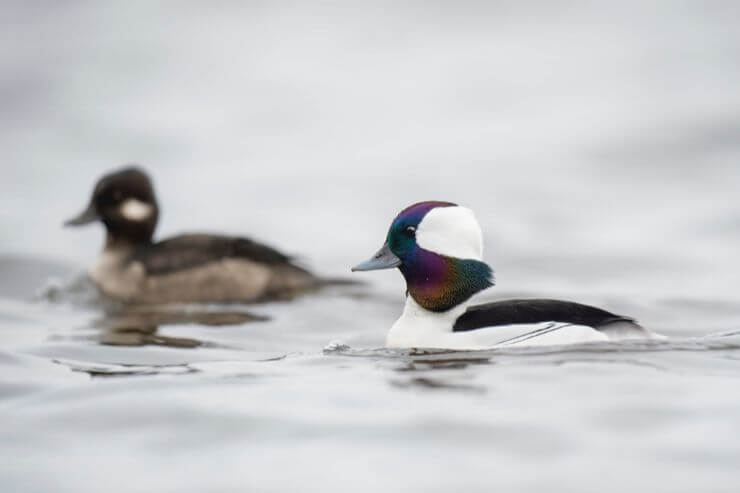
Buffleheads nest in tree cavities, often using old woodpecker holes. They prefer sites near water, ensuring easy access to feeding areas for their young. These secure nesting sites help protect their eggs and ducklings from predators.
Their diet consists mainly of aquatic invertebrates, such as insects and crustaceans. Buffleheads dive to forage, showcasing their agility and skill in hunting underwater. This diet supports their energetic lifestyle and growth.
Conservation efforts for Buffleheads include protecting nesting sites and maintaining clean waterways. Buffleheads benefit from nest box programs and wetland preservation, helping to sustain their populations in the wild and ensuring their continued presence in diverse habitats.
4. Cinnamon Teal
- Scientific name: Spatula cyanoptera
- Life span: 7-10 years
- Size: 15-16 in (38-41 cm)
- Weight: 12-15 oz (340-425 grams)
- Wingspan: 24-26 in (61-66 cm)
- Status: Least Concern
- State status: Breeding and rare
The Cinnamon Teal is a small, striking duck with males displaying bright cinnamon-red plumage. Found in the western United States, Central America, and South America, they inhabit shallow freshwater marshes and ponds.

Cinnamon Teal nest in dense vegetation near shallow wetlands. The female constructs a nest on the ground, often hidden by tall grasses or reeds, and lines it with down. She lays around 7-10 eggs, with an incubation period of 21-25 days. They prefer secluded, marshy areas for nesting.
Cinnamon Teal primarily feed on aquatic plants, seeds, and small invertebrates. They forage in shallow waters, dabbling and tipping forward to reach submerged vegetation. Their diet changes seasonally, with a higher intake of invertebrates during the breeding season for additional protein.
Cinnamon Teal populations benefit from wetland conservation initiatives. Historically, their numbers have been stable, but habitat loss and water management practices pose ongoing threats. Conservation programs that focus on wetland restoration and protection are vital for maintaining healthy populations of this strikingly colored duck.
5. American Wigeon
- Scientific name: Mareca americana
- Life span: 12-15 years
- Size: 42-59 cm (17-23 in)
- Weight: 600-1200 g (1.3-2.6 lb)
- Wingspan: 76-91 cm (30-36 in)
- Status: Least Concern
- State status: Migratory and common
American Wigeons are easily identifiable by their distinctive green eye patch on males and their overall brownish-gray body. These ducks breed in the northwestern United States and Canada and migrate to the southern U.S. and Central America for the winter.

American Wigeons typically nest in upland areas, often far from water. The female constructs a nest on the ground, concealed by dense vegetation, and lines it with down. She lays about 6-12 eggs, and incubation lasts around 23-25 days. Wigeons often nest near wet meadows or grasslands.
American Wigeons primarily feed on aquatic plants and grasses, often grazing on land like geese. They also dabble in shallow waters for algae and other vegetation. In winter, they may consume more agricultural grains and seeds. Their diet reflects their preference for habitats with abundant plant life.
American Wigeons benefit from wetland conservation programs that protect their breeding and wintering habitats. Historically, their populations have remained relatively stable, but habitat destruction and changes in water management pose ongoing threats. Conservation organizations work to maintain healthy wetland ecosystems to support these ducks throughout their range.
6. Green-winged Teal
- Scientific name: Anas crecca
- Life span: 5-10 years
- Size: 33-38 cm (13-15 in)
- Weight: 150-400 g (5.3-14.1 oz)
- Wingspan: 53-59 cm (21-23 in)
- Status: Least Concern
- State status: Breeding and common
Green-winged Teals are small, colorful ducks with vibrant green wing patches and a striking green stripe on the head of males. They are widespread across North America, breeding in northern regions and wintering in the southern U.S. and Central America.

Green-winged Teals nest on the ground, often near water, in dense vegetation. Their nests are well-hidden, providing safety for their eggs from predators and harsh weather conditions. This nesting strategy helps increase the chances of survival for their young.
Their diet includes seeds, aquatic plants, and invertebrates. Green-winged Teals forage in shallow waters and mudflats, using their bills to filter food from the water. This feeding behavior supports their nutritional needs and helps maintain their health.
Conservation efforts for Green-winged Teals focus on protecting and restoring wetland habitats. These small ducks benefit from wetland conservation programs, which help maintain healthy populations despite environmental pressures. Ongoing efforts aim to ensure their continued presence in their natural habitats.
7. Lesser Scaup
- Scientific name: Aythya affinis
- Life span: 12-15 years
- Size: 38-48 cm (15-19 in)
- Weight: 400-1000 g (0.88-2.2 lb)
- Wingspan: 64-74 cm (25-29 in)
- Status: Least Concern
- State status: Migratory and common
Lesser Scaups are similar to Greater Scaups but are slightly smaller with a more peaked head. They are widespread across North America, breeding in the northern regions and wintering in the southern U.S. and Central America, favouring lakes and coastal bays.
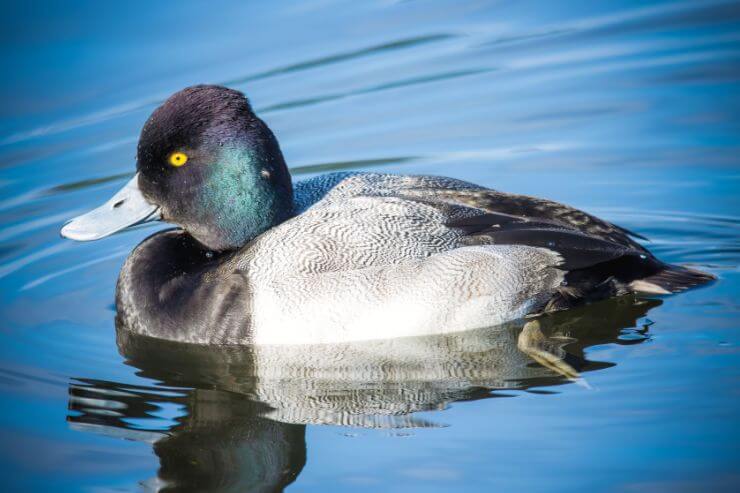
Lesser Scaups nest in marshy areas, using grass and down to construct their nests. They often select sites near water bodies, which ensures easy access to feeding grounds for their ducklings. The nests are well-concealed among the vegetation, providing safety from potential predators.
Lesser Scaups feed on a variety of aquatic invertebrates and plants. Their diet includes insects, crustaceans, and seeds, which they find by diving and foraging in shallow waters. Their adaptable feeding habits allow them to thrive in various aquatic environments.
Conservation measures for Lesser Scaups include habitat restoration and pollution control. The species has experienced population declines, but ongoing conservation initiatives aim to ensure stable and healthy populations by addressing the primary threats to their habitats and promoting sustainable practices.
8. Surf Scoter
- Scientific name: Melanitta perspicillata
- Life span: 10-20 years
- Size: 45-54 cm (18-21 in)
- Weight: 710-1,980 g (1.6-4.4 lb)
- Wingspan: 76-91 cm (30-36 in)
- Status: Least Concern
- State status: Migratory and rare
Surf Scoters are striking sea ducks with bold black and white plumage and a colorful bill. Found along the Pacific and Atlantic coasts of North America, they are commonly seen in coastal waters and estuaries during winter.

Surf Scoters nest on the ground, typically in secluded, forested areas near water. Their nests are lined with down feathers, providing warmth and protection for the eggs. These nesting sites are chosen to be hidden and secure, away from predators.
These sea ducks are known for their diving abilities, primarily eating mollusks, crustaceans, and small fish. They are often seen bobbing in the surf, skillfully catching their prey beneath the waves, demonstrating their adeptness at navigating turbulent waters.
Conservation efforts for Surf Scoters focus on protecting coastal and marine environments. Pollution and habitat destruction have significantly impacted their numbers, but marine reserves and pollution reduction efforts are crucial in supporting their recovery and ensuring the sustainability of their habitats.
9. Greater Scaup
- Scientific name: Aythya marila
- Life span: 10-20 years
- Size: 41-51 cm (16-20 in)
- Weight: 900-1,600 g (2-3.5 lb)
- Wingspan: 81-87 cm (32-34 in)
- Status: Least Concern
- State status: Migratory and common
Greater Scaups are diving ducks with striking black and white plumage and a distinctive greenish sheen on their heads. They breed in the northern tundra of North America and Eurasia and migrate to coastal waters and large inland lakes for winter.

Greater Scaups prefer nesting near freshwater lakes and ponds, often choosing sites surrounded by dense vegetation. They build their nests with grasses and down feathers, creating a cozy and well-hidden environment to protect their eggs from predators and harsh weather conditions.
These diving ducks have a varied diet primarily consisting of aquatic invertebrates and plants. They dive deep into the water to find snails, clams, and small fish. Their skillful underwater foraging makes them efficient hunters, contributing to their robust diet.
Conservation efforts for Greater Scaups focus on preserving wetland habitats and maintaining clean waterways. The population has seen fluctuations due to habitat loss and pollution, but dedicated protected areas and initiatives to reduce water pollution are helping stabilize their numbers, ensuring a healthier future for these diving ducks.
10. Ruddy Duck
- Scientific name: Oxyura jamaicensis
- Life span: 6-8 years
- Size: 36-43 cm (14-17 in)
- Weight: 430-790 g (0.95-1.74 lb)
- Wingspan: 61-74 cm (24-29 in)
- Status: Least Concern
- State status: Migratory and common
Ruddy Ducks are small, stout ducks with striking blue bills and bright chestnut bodies in males. Found across North America, they breed in marshes and ponds in the western U.S. and Canada and migrate to the southern U.S. and Central America for winter.
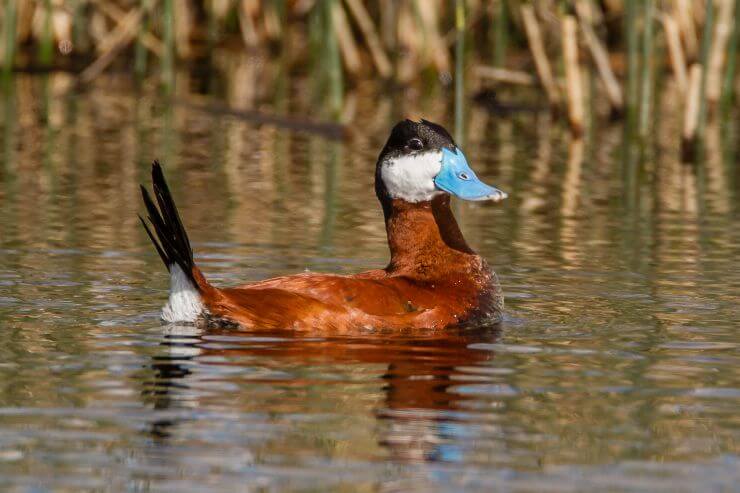
Ruddy Ducks build their nests among dense marsh vegetation. These compact nests, woven from reeds and grasses, are often anchored to plants, floating on the water’s surface. This floating design hides and protects their eggs from predators.
Their diet includes a variety of aquatic invertebrates and plant seeds. Ruddy Ducks are active foragers, diving and dabbling in wetlands to find food. They thrive in rich wetland ecosystems by consuming insects, larvae, crustaceans, and small aquatic plants.
Conservation efforts for Ruddy Ducks focus on protecting wetland habitats from pollution and encroachment. These initiatives include reducing water pollution, restoring degraded wetlands, and creating protected areas.
11. Black Scoter
- Scientific name: Melanitta americana
- Life span: 10-15 years
- Size: 43-54 cm (17-21 in)
- Weight: 30.4-38.8 oz (862-1100 g)
- Wingspan: 79-91 cm (31-36 in)
- Status: Least Concern
- State status: Migratory and rare
Black Scoters are characterized by their entirely black plumage in males and a distinct yellow knob at the base of the bill. These sea ducks are found along the coasts of North America, from breeding grounds in the Arctic to wintering areas along the Atlantic and Pacific coasts.
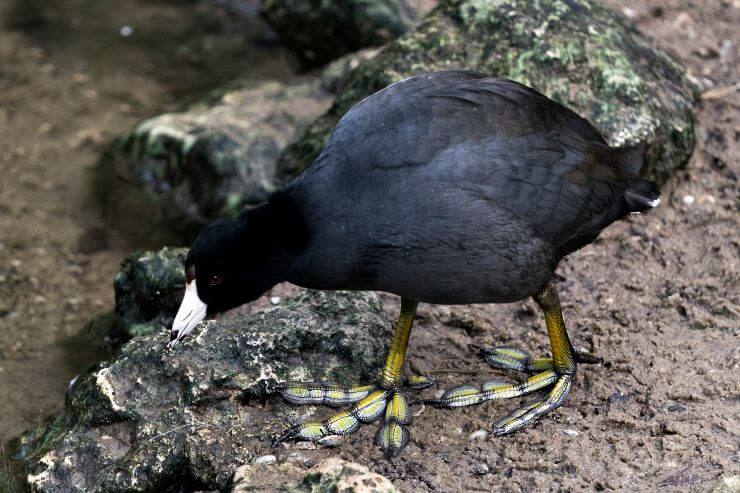
Black Scoters prefer nesting near freshwater lakes in northern tundra regions. Their nests are shallow depressions lined with down feathers and hidden in dense vegetation, providing protection for their eggs from predators and harsh weather.
Black Scoters primarily consume mollusks and crustaceans, diving to forage for food often in coastal waters. Their adept swimming and diving abilities enable them to efficiently locate and capture their prey in their aquatic habitats.
Conservation strategies for Black Scoters include habitat protection and population monitoring. Human activities and environmental changes threaten their habitats, but efforts aim to ensure their continued presence in natural ecosystems through habitat preservation and pollution control initiatives.
12. Northern Shoveler
- Scientific name: Spatula clypeata
- Life span: 10-15 years
- Size: 43-53 cm (17-21 in)
- Weight: 400-1100 g (0.88-2.4 lb)
- Wingspan: 74-86 cm (29-34 in)
- Status: Least Concern
- State status: Breeding and common
Known for their distinctive spatula-shaped bill, Northern Shovelers have a striking plumage with males showcasing green heads and chestnut flanks. These ducks are found across North America and Eurasia, thriving in shallow wetlands and marshes.

Northern Shovelers nest in grassy areas near water, using their distinctive spoon-shaped bills to forage in shallow wetlands. The female builds a nest on the ground, hidden by dense vegetation, and lines it with down. She lays about 8-12 eggs, and the incubation period is around 24-26 days.
Northern Shovelers are filter feeders, using their specialized bills to strain small aquatic invertebrates and plant matter from the water. They often feed in shallow wetlands, sweeping their bills from side to side to capture food. Their diet includes plankton, crustaceans, and seeds.
Northern Shovelers have stable populations, but they are dependent on healthy wetland ecosystems. Conservation efforts focus on preserving and restoring wetlands, which are essential for their feeding and breeding. Programs like the North American Waterfowl Management Plan help ensure these habitats are protected for future generations of shovelers.
13. Blue-winged Teal
- Scientific name: Spatula discors
- Life span: 5-10 years
- Size: 40-47 cm (16-19 in)
- Weight: 280-420 g (9.9-14.8 oz)
- Wingspan: 58-63 cm (23-25 in)
- Status: Least Concern
- State status: Breeding and common
Blue-winged Teals are small, dabbling ducks with striking blue patches on their wings. They breed in the northern U.S. and Canada and migrate to the southern U.S., Central America, and South America, favoring shallow wetlands.
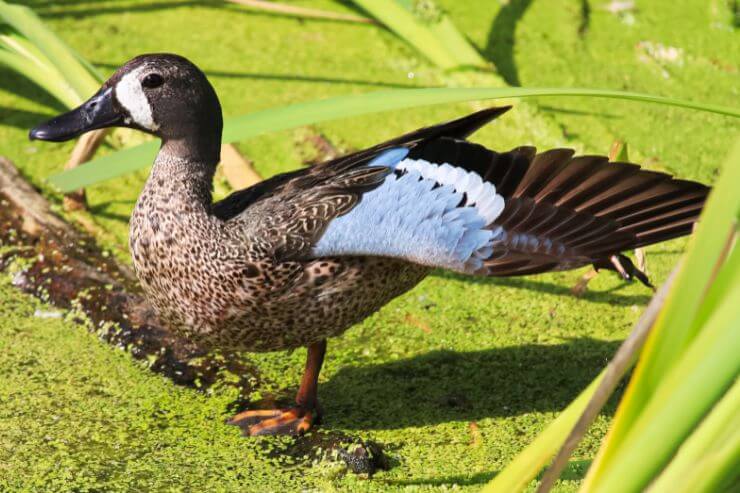
Blue-winged Teals nest in grasslands and marshes, often far from water. Their nests are concealed in dense vegetation, providing protection for their eggs and young from predators. This strategic nesting behavior helps ensure the survival of their offspring.
Their diet includes seeds, aquatic plants, and insects. Blue-winged Teals forage in shallow waters and mudflats, using their bills to sift through the water for food. This adaptable feeding strategy allows them to thrive in various wetland habitats.
Conservation efforts for Blue-winged Teals focus on wetland preservation and habitat restoration. These birds have benefited from these initiatives, but ongoing habitat loss and environmental changes require continued conservation actions to ensure their future and maintain healthy populations.
14. Ring-necked Duck
- Scientific name: Aythya collaris
- Life span: 5-10 years
- Size: 39-46 cm (15-18 in)
- Weight: 680-1,360 g (1.5-3 lb)
- Wingspan: 63-76 cm (25-30 in)
- Status: Least Concern
- State status: Migratory and common
Ring-necked Ducks have a distinctive black back and white belly, with a subtle chestnut ring around their neck. Found across North America, these ducks inhabit freshwater lakes, ponds, and rivers, often migrating to the southern U.S. for winter.

Ring-necked Ducks nest in dense vegetation near water, often choosing secluded areas. The female constructs a nest on the ground or in floating vegetation, lining it with down. She lays about 8-10 eggs, with an incubation period of 25-29 days. They prefer shallow, marshy wetlands for nesting.
Ring-necked Ducks primarily feed on aquatic plants, seeds, and invertebrates. They are diving ducks, foraging underwater for their food. Their diet includes a variety of plant matter and small aquatic animals, reflecting their adaptability to different wetland habitats.
Ring-necked Duck populations are generally stable, but they depend on healthy wetland ecosystems. Conservation efforts focus on preserving and restoring wetlands, which are essential for their feeding and breeding. Programs like the North American Waterfowl Management Plan help ensure these habitats are protected.
15. White-winged Scoter
- Scientific name: Melanitta fusca
- Life span: 10-15 years
- Size: 48-58 cm (19-23 in)
- Weight: 900-2,800 g (2-6.2 lb)
- Wingspan: 81-97 cm (32-38 in)
- Status: Least Concern
- State status: Migratory and common
White-winged Scoters are large sea ducks with distinctive white wing patches and a mostly dark body. They breed in the northern interior of North America and migrate to coastal waters for winter, often seen in large flocks.

White-winged Scoters nest in tundra regions, selecting sites close to water bodies. Their nests, hidden among dense vegetation, provide safety and warmth for their eggs. These secluded sites help protect the eggs and young from predators and the elements.
These birds are adept at diving deep for aquatic prey, including mollusks, crustaceans, and fish. They navigate underwater with ease to find their food, showcasing their excellent diving skills and adaptation to aquatic life.
Conservation efforts for White-winged Scoters are directed at preserving their northern breeding habitats. Environmental changes and human activities pose significant threats to their populations, but targeted conservation actions aim to mitigate these impacts and support the stability and health of their populations.
16. Common Merganser
- Scientific name: Mergus merganser
- Life span: 10-15 years
- Size: 22-28 in (56-71 cm)
- Weight: 2-4 lbs (0.9-1.8 kg)
- Wingspan: 26-29 in (66-74 cm)
- Status: Least Concern
- State status: Migratory and common
Common Mergansers are striking ducks with a sleek profile and bright white bodies in males. Found in rivers and lakes across North America, Europe, and Asia, they are adept divers, often seen hunting fish in clear waters.

Common Mergansers nest in tree cavities, often near rivers and lakes. They also use nest boxes, providing safe sites for laying eggs and raising their young. These nesting sites ensure proximity to water, essential for their ducklings’ growth and development.
These expert divers mainly eat fish, which they catch with their serrated bills. They also consume aquatic invertebrates, showcasing their efficient hunting skills in freshwater habitats. Their diet makes them important indicators of healthy aquatic ecosystems.
Conservation efforts for Common Mergansers focus on protecting clean waterways and suitable nesting sites. Pollution and habitat degradation have impacted their populations, but conservation initiatives aim to ensure their survival and health by preserving their natural habitats and addressing pollution sources.
17. Northern Pintail
- Scientific name: Anas acuta
- Life span: 10-15 years
- Size: 56-66 cm (22-26 in)
- Weight: 450-1150 g (1-2.5 lb
- Wingspan: 80-95 cm (31-38 in)
- Status: Least Concern
- State status: Migratory and common
The Northern Pintail boasts a sleek silhouette with a long, pointed tail and elegant neck. Males display a striking combination of brown, white, and black plumage. These ducks are widespread across North America, Europe, and Asia, favouring shallow wetlands and marshes.
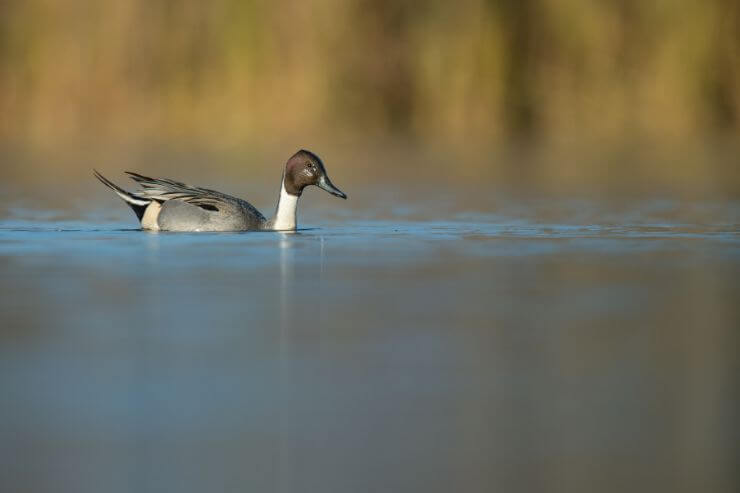
Northern Pintails prefer open habitats for nesting, often choosing grassy fields or wet meadows away from dense cover. The female creates a shallow scrape in the ground, lining it with down feathers and plant material. They lay around 7-10 eggs, with incubation lasting approximately 23-24 days. Their nesting sites are usually far from water, which is unique among ducks.
Northern Pintails feed mainly on seeds, aquatic plants, and small invertebrates. They often forage in shallow waters, dabbling and tipping forward to reach submerged vegetation. Their diet varies seasonally, relying more on plant matter during breeding season and shifting to a higher proportion of invertebrates when those are more available.
Northern Pintails have experienced population declines due to habitat loss and changes in agricultural practices. Conservation efforts focus on preserving and restoring wetland habitats and grasslands. Initiatives by wildlife agencies and organizations like the North American Waterfowl Management Plan aim to reverse these declines by improving breeding and wintering habitats across their range.
18. Canvasback
- Scientific name: Aythya valisineria
- Life span: 10-15 years
- Size: 48-56 cm (19-22 in)
- Weight: 1,270-1,800 g (2.8-4 lb)
- Wingspan: 84-89 cm (33-35 in)
- Status: Vulnerable
- State status: Migratory and common
Canvasbacks are elegant ducks with a distinctive sloping forehead and a striking red eye in males. Their range extends across North America, from the northern breeding grounds in Canada to wintering sites in the southern U.S. and Mexico.

Canvasbacks nest in dense emergent vegetation over water, building floating nests anchored to plants. The female constructs the nest using reeds and grasses, lining it with down. She lays about 5-11 eggs, with an incubation period of 24-29 days. They prefer large, permanent wetlands with abundant aquatic vegetation.
Canvasbacks primarily feed on aquatic plants, seeds, and tubers. They are diving ducks, foraging underwater for their food. In winter, their diet includes more animal matter, such as mollusks and small fish. Their preference for submerged vegetation makes them dependent on healthy wetland ecosystems.
Canvasbacks have faced population declines due to habitat loss and changes in water quality. Conservation efforts focus on preserving and restoring their wetland habitats. Historically, their populations have fluctuated, but ongoing conservation initiatives aim to provide stable breeding and wintering grounds for these distinctive diving ducks.
19. Wood Duck
- Scientific name: Aix sponsa
- Life span: 5-10 years
- Size: 48-54 cm (19-21 in)
- Weight: 454-862 g (1-1.9 lb)
- Wingspan: 66-73 cm (26-29 in)
- Status: Least Concern
- State status: Breeding and common
Wood Ducks are among the most colorful waterfowl, with males displaying iridescent greens, purples, and whites. They inhabit wooded swamps, marshes, and streams across North America, often nesting in tree cavities near water.

Wood Ducks nest in tree cavities near water, often utilizing old woodpecker holes. They also readily accept nest boxes provided by conservationists, aiding in boosting their population. These nesting sites ensure safety and proximity to feeding grounds for their ducklings.
Their diet includes seeds, fruits, insects, and aquatic plants. Wood Ducks forage in shallow waters and along wetland edges, demonstrating their versatile feeding habits. Their varied diet helps them thrive in diverse habitats, from forests to marshes.
Conservation efforts have significantly benefited Wood Duck populations, including nest box programs and habitat restoration. Once in decline due to habitat loss and hunting, these colorful ducks have rebounded thanks to dedicated conservation actions, showcasing a successful recovery story.
20. Hooded Merganser
- Scientific name: Lophodytes cucullatus
- Life span: 6-12 years
- Size: 40-49 cm (16-19 in)
- Weight: 400-700 g (0.88-1.54 lb)
- Wingspan: 63-76 cm (25-30 in)
- Status: Least Concern
- State status: Migratory and common
Hooded Mergansers are small, striking ducks with distinctive fan-shaped crests and bold black-and-white patterns in males. Found in forested wetlands across North America, they are often seen in clear, shallow waters.

Hooded Mergansers nest in tree cavities, often using old woodpecker holes or nest boxes. They prefer sites near water, ensuring easy access to feeding areas for their ducklings. These secure nesting sites help protect their young from predators.
Their diet consists mainly of fish, which they catch with their serrated bills. They also eat aquatic insects and crustaceans, diving skillfully to find their food in freshwater habitats. This diverse diet supports their health and growth.
Conservation actions for Hooded Mergansers focus on providing nesting sites and protecting clean waterways. They benefit from nest box programs and wetland preservation, helping to stabilize and increase their populations, demonstrating the importance of targeted conservation efforts.
21. Red-breasted Merganser
- Scientific name: Mergus serrator
- Life span: 9-14 years
- Size: 54-62 cm (21-24 in)
- Weight: 700-1,600 g (1.5-3.5 lb)
- Wingspan: 66-81 cm (26-32 in)
- Status: Least Concern
- State status: Migratory and common
Red-breasted Mergansers have distinctive shaggy crests and striking red eyes. These sea ducks breed in the northern regions of North America and Eurasia and migrate to coastal waters during winter, favouring estuaries and bays.
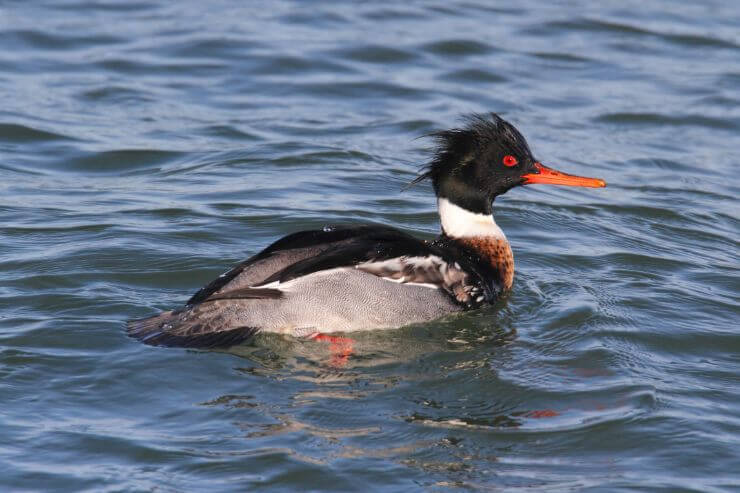
Red-breasted Mergansers nest on the ground, often near water, hidden in dense vegetation. Their nests are well-concealed, providing safety for their eggs from predators. These nesting habits ensure that their young are raised in secure environments close to feeding areas.
These birds primarily eat fish, diving underwater to catch their prey with their slender, serrated bills. They also consume crustaceans and other aquatic invertebrates, showcasing their versatile diet and adaptation to various aquatic environments.
Conservation efforts for Red-breasted Mergansers include protecting coastal and freshwater habitats. Pollution and habitat loss pose significant threats, but ongoing efforts aim to mitigate these impacts and support stable populations, ensuring these birds continue to thrive in their natural environments.
22. Redhead
- Scientific name: Aythya americana
- Life span: 10-15 years
- Size: 42-49 cm (17-19 in)
- Weight: 850-1,600 g (1.9-3.5 lb)
- Wingspan: 76-84 cm (30-33 in)
- Status: Least Concern
- State status: Migratory and common
The Redhead duck is known for its rich, reddish-brown head and gray body. These ducks are commonly found across North America, from breeding grounds in the northern U.S. and Canada to wintering areas in the southern U.S. and Mexico.
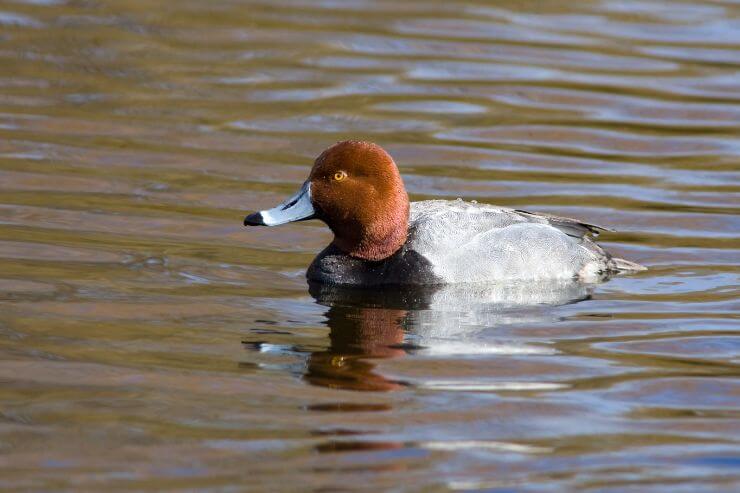
Redheads often nest over water, constructing floating nests anchored to vegetation. The female builds the nest using reeds and grasses, lining it with down. She lays about 7-10 eggs, with an incubation period of 24-28 days. Redheads prefer large marshes and wetlands with dense vegetation.
Redheads primarily feed on aquatic plants, seeds, and invertebrates. They are diving ducks, foraging underwater for their food. Their diet varies seasonally, with a higher intake of animal matter during the breeding season for extra protein. They prefer habitats with abundant submerged vegetation.
Redhead populations have been stable, but they are vulnerable to habitat loss and changes in water quality. Conservation efforts focus on protecting and restoring wetlands, which are crucial for their breeding and feeding. Organizations like Ducks Unlimited work to maintain healthy habitats for these striking ducks.
Where to find Ducks in California
Finding ducks in California is a rewarding experience for bird watchers and nature enthusiasts alike. To catch sight of these waterfowl, head to one of California’s abundant wetlands and wildlife refuges. Early mornings or late afternoons are the best times to visit, as ducks are most active during these hours. Bring binoculars, a field guide, and plenty of patience. Four prime spots to explore include:
- Sacramento National Wildlife Refuge: This refuge hosts thousands of ducks, especially during migration season. Boardwalks and viewing platforms make it easy to spot different species.
- San Luis National Wildlife Refuge: Known for its diverse habitats, it’s a great place to see ducks up close, particularly in the managed wetlands and ponds.
- Gray Lodge Wildlife Area: Located in the Sacramento Valley, this area is famous for its wintering waterfowl. The auto-tour route offers excellent viewing opportunities.
- Bolsa Chica Ecological Reserve: This coastal spot is ideal for observing ducks year-round. Trails wind through marshlands, offering glimpses of a variety of duck species.
Exploring these areas not only enhances your chances of seeing ducks but also deepens your appreciation for California’s natural beauty.
Conclusion
Exploring the diverse habitats of California’s ducks offers a unique glimpse into the state’s vibrant wildlife. From tranquil wetlands to bustling refuges, these areas showcase the importance of conservation. Whether you’re an avid bird watcher or a curious visitor, the sight of these graceful birds will leave you inspired.

